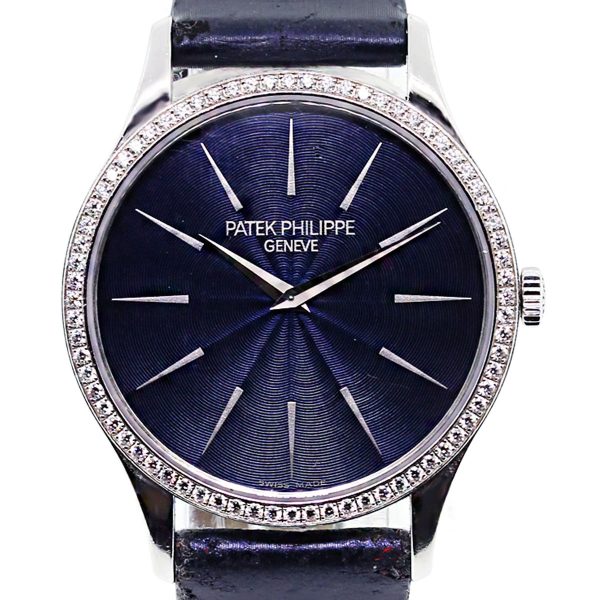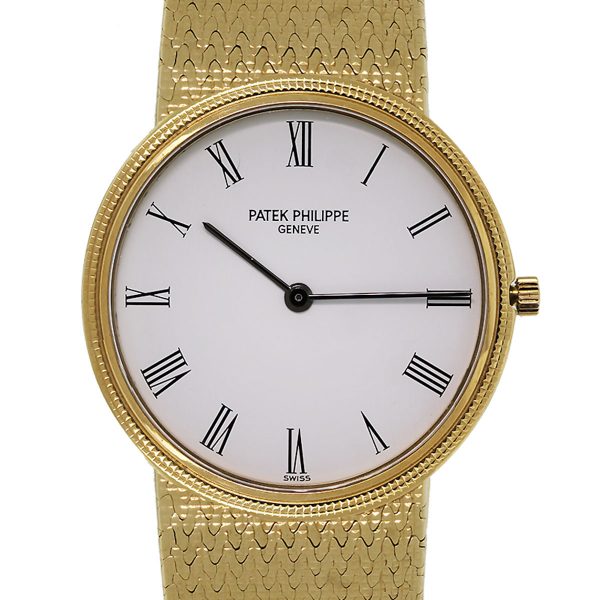INTRODUCING PATEK PHILIPPE CALATRAVA
With a fresh design and a modern movement, here is one of Patek Philippe’s most valuable classics.
This famous Calatrava variety comes with a guilloche hobnail bezel. This collection is one of the most outstanding examples of the trademark Patek Philippe design.
Excitingly, this collection comes with watches with a definitive modern appearance. The design of these watches is unique. Now, you get a watch with a narrowly bigger diameter. Plus, a dial that comes with the applied hour markers feature.
Also, these elegant, slender, and grand women’s and men’s wristwatches in white gold or rose come with a new addition. Now, there is a completely different manually wound Patek Philippe movement. This movement comes with a power reserve that lasts up to 65 hours.
These are only a few of the several amazing features wristwatches in this collection come with.
Background Of The Patek Philippe Calatrava
The Patek Philippe Calatrava began production in 1932 as the Ref. 96. This was the first model of this timepiece that had a reference number. Thereafter, the Calatrava defined itself as the standard for the classic round wristwatch.
Patek Philippe regards this watch as one of the most elegant expressions of timeless beauty. Its flawless design reproduces the minimalistic Bauhaus principle. This principle states that function defines the form of an item.
Over time, there are numerous remodels of the Patek Philippe Calatrava. There are various editions for the gents and the ladies.
Most of these editions came with narrowly circular or flat bezels. They are flawlessly refined, and set with precious rocks or guilloched. Most of these models were either ultra-thin or striking.
Again, they featured smooth dials and officer’s cases. Their dials only revealed the minutes and the hours. Occasionally, it displays the seconds or other indications.
In no time, the Patek Philippe Calatrava became one of the brand’s most extensive collections.
The Remarkable Models And Evolution Over The Years
As more of the Calatrava models came out, some soon drew in significant awareness with lingering impressions. These were mostly the editions with guilloche hobnail patterns featured on their bezels.
This diamond-polished motif made of tiny pyramid studs made its first appearance on the bezel of Calatrava the Ref. 96 Décor in 1934. Also, this reference came with the exact manually wound caliber 12-120 movement.
Furthermore, it featured similar curved lugs and a replica of the dial. The dial featured applied hour markers and tiny seconds just like Ref. 96.
In 1972, this kind of bezel again appeared on the manually wound Ref. 3520D (caliber 177). This time with hours and minutes, straight lugs, and Roman numerals.
In the year 1985, Patek Philippe debuted a Calatrava that went on to make impacts. This edition became one of the most famous wristwatches in the world of horology. This was the legendary Ref. 3919. It featured the manually wound caliber 215 PS, and subsidiary seconds at 6 o’clock.
Plus, the model also had straight lugs and a white dial with black lacquered Roman numerals.
The Evolution Of The Calatrava Collection
The production of this model lasted for more than two decades. During this period, there were also editions with lesser diameters to suit a feminine wrist. Some of them are:
- The Ref. 4819 produced in 1987 with a quartz movement
- The Ref. 4820 produced in 1988 with a quartz movement and also with a gem-set bezel
- The Ref. 4809 produced in 1991 with the manually wound caliber 16-250 movement.
- The Ref. 5115 produced in 2000 with the manually wound caliber 215 PS came again. This time, it had the curved lugs taken from the Ref. 96D.
- The Ref. 5120 with straight lugs and a self-winding caliber 240 movements launched in 2001. This model had narrowly lengthened, neater Roman numerals. The case was larger too. (36 mm rather than the typical 33.5 mm)
- The Ref. 5119 produced in 2006 as a remake of Ref. 3919. It maintains the manually wound caliber 215 PS and the straight lugs.
- In 2009, there came the Ref. 5116 with a dial-in grand feu enamel.
- In 2016, Ref. 6300 was produced. It featured a guilloche hobnail motif on the case sides and one of the two dials.
- Then, there was the Grandmaster Chime which is Patek Philippe’s most complicated timepiece. It emphasized the value of this decoration that is so specific to the brand.
Lastly, since 2018, aside from a few rare handcraft versions like the Ref. 5177, something changed. The “Clous de Paris” pattern no longer emerged in Patek Philippe’s recent collection. This is a typical way the brand prepares to have a huge rebirth.
The Design Of The Patek Philippe Calatrava
Patek Philippe furnished its different models with diverse design features. However, all of these features take inspiration from the trademarks of the brand. For instance, this Calatrava “Clous de Paris” comes with fresh élan. The brand updated its classic design in a very modern way.
This edition defines itself primarily with a barely bigger diameter of 39 mm. This model indicates the evolving preferences of our time
Again, it intensifies its presence on the wrist without adjusting the sleek refinement of its case.
-
The Dial
There are several design changes on the dial of watches with this model. Editions like the Refs. 5119 and 3919 have black lacquered Roman numerals displayed on a white background.
This feature is out now and what is new are the faceted “obus” markers. They come in 18K gold and display double markers at the 12 o’clock position. These markers underline the timelessly elegant feature of the dial. Plus, it has a bigger diameter.
With the dials on these models, Patek Philippe returned to the base of the Calatrava design. These design features also appear in Refs. 96 produced in 1932 and 96D produced in 1934.
Also, the watch’s hour and minute hands come in the gold dauphine style. This also references Ref. 96 except for the fact that there are three instead of two facets.
With these different dial’s design, you can be sure of one thing. You will get exceptional legibility. The railway-track minute scale featured at the periphery of the dial further adds to the elegance.
Check out the slender “cheveu”-style seconds hand on most dials. The hands-on subsidiary subdial at the 6 o’clock position comes in a four-quarter division.
-
The Bezel
The circular bezel comes with decoration similar to a guilloche hobnail structure. Also, the bezel displays a narrowly wider chamfered profile. Also, there is a tiny, coated fillet that edges the box-form sapphire crystal.
The pattern of the strap lugs had some modifications too. Just like the straight lugs of Ref. 3919, you have new curved lugs motivated by Ref. 96. Also, there are the self-winding Calatrava models inspired by the 1990 model.
The design of the bezel generates an excellent transition to the strap from the case. This means that you get a relaxed fit.
- The Case
This latest edition of the Patek Philippe comes with a novel design. This latest creation is one of the brand’s elegant classics. The Patek Philippe Calatrava comes in various types, same as the case.
For instance, Ref. 6119R-001 blends a silvery grained dial with a rose-gold case. This edition comes with applied hour arrows and hands in rose gold. This watch is suspended on a sleek chocolate brown alligator strap. The strap is fastened by a rose-gold prong buckle.
Also, there is Ref. 6119G-001. It comes in white gold and subtly sports brilliance on a charcoal gray dial with desirable distinctions. No one wants to miss out on this watch with a vertical satin finish.
The snailed subsidiary seconds dial interrupts the design with a unique touch. The applied hour pointers and hands are products of the exact metal used for the case. For this timepiece, there is a polished black alligator strap fastened by a white-gold prong buckle.
The Movement Of The Patek Philippe Calatrava
Most of the movements are new and are manually wound movement.
With the input of an entirely new manually wound movement, the recent models flagged off a new era.
The Ref. 6119 Calatrava “Clous de Paris” is the model that defines this new landmark. The launch of this model gives Patek Philippe the chance to introduce a spanking new base movement. This new movement enhances the wide variety of the brand’s calibers.
Its introduction is a result of the longing to possess a manually wound movement. This type of movement presents a bigger diameter than the caliber 215 PS. Now, the production of incredibly sleek cases as a requirement for timeless elegance is possible.
-
The Design Of The Movement
This new caliber 30-255 PS comes with an interior case diameter of 30.4 mm. However, the total diameter measures a total of 31 mm. This is different from the 21.5 mm used in the 215 PS. That edition had an entire diameter of 21.9 mm. Also, this edition featured an unchanged height of 2.55 mm as reflected in its tag.
Furthermore, conscious efforts went into maintaining the height of 2.55 mm of the caliber 215 movements. These efforts came from the designers and engineers of the brand. They executed various creative solutions.
Some of these remedies include:
-
- A central pinion void of a wheel plate. This pinion webs with the center wheel through an intervening wheel
- A crown and a ratchet wheel placed below the barrel bridge rather than on top of it.
-
The Power Reserve Of The Movement
For the caliber 30-255 PS, the brand makes a huge call by presenting an impressive power reserve. The caliber is extremely powerful and dominant with a power reserve that lasts up to 65 hours. That is as long as three days.
An outstanding aspect of the movement is its two mainspring barrels arranged in a parallel pattern. They sit together and connect to the central pinion in a format that is hardly employed. This is different from how barrels bind in series.
To broaden the power reserve, parallel barrels boost the torque of the movement. They do this by enhancing the torque of both barrels. This particular remedy favors full force not minding the slim architecture. Besides, it permits the deployment of a symmetry with two times the moment of inertia of 10 mg.cm2.
This passes as the highest moment of inertia used in all of Patek Philippe Calatrava’s 4-Hz movements.
Benefits of The Patek Philippe Calatrava Collection
Why opt for a Patek Philippe Calatrava timepiece? There are benefits offered by watches featured in this collection. Some of them are:
- These timepieces parade excellent designs
- Also, the movement of these watches boasts rate stability
- The precision adjustment of the watch is at a premium.
- In addition, the watches feature a desirable power reserve capacity.
- Thanks to the stop-seconds feature you can set the time using one-second precision. As soon as you push the crown home, the mechanism starts working.
- The Calatrava collection is a combination of artistic expression and a good representation of technical expertise. Hence, with the Calatrava wristwatches, you have a good blend of beauty and functionality.
Conclusion
The biggest attraction the Patek Philippe Calatrava has is in its dial. The brand stayed away from the complicated designs of the Art Deco era that preceded the production.
Additionally, this collection of watches continues to show restraint in its design and production. All the brand opts for is a legible time display. The markers for the hours and minutes followed this motive in their design and production. The tipped and faceted Dauphine arrows in gold ensured that the indication of the hours and minutes was perfect. And, that was a wrap!
Therefore, it is enough to conclude that the Patek Philippe Calatrava was a tremendous success for the brand. Now, Patek Philippe boasts of another cornerstone collection. And, from the tons of variations produced over time, one can say the brand pays attention to this collection. Presently, the closest variation of the first Calatrava is the Ref 5296 model.
To grab a copy of any of these time tools, contact Raymond Lee Jewelers today!





